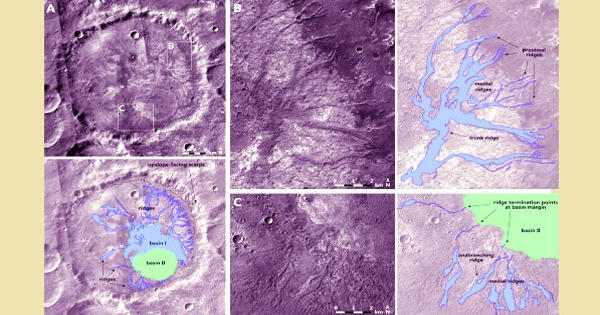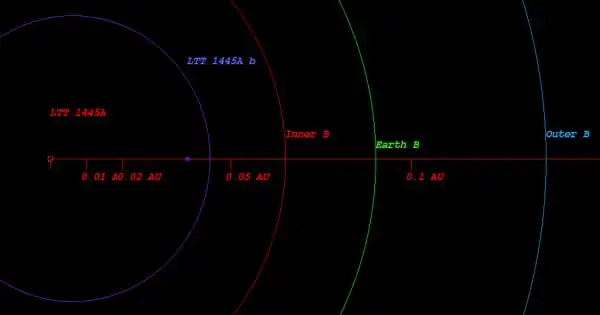According to new Brown University research, a 54-km- (33.5-mile) diameter Noachian-aged crater with no inlet or outlet channels is distinct from previously documented crater basin lakes on the planet.
As the Mars 2020 Perseverance rover continues its journey across Mars, all eyes are on the Jezero crater. However, scientists at Brown University in the United States have discovered a previously unknown type of ancient crater lake on Mars, which could reveal information about the planet’s early climate.
According to their findings, the system was most likely fed by runoff from a long-lost Martian glacier. “Because the water flowed into the crater atop the glacier, it did not leave behind a valley as it would have if it had flowed directly on the ground. The water eventually emptied into the low-lying crater floor, leaving its geological mark on the bare Martian soil, according to the press release.
The newly-discovered ‘closed-source drainage basin’ crater is located in the southern highlands of Mars.
It has unusually well-preserved stream beds, ponds, and deposits that formed entirely within the crater. There is, however, no evidence of inlet channels where water could have entered the crater from the outside, nor of groundwater activity where it could have bubbled up from below.
“This is a previously unknown type of hydrological system on Mars,” said Ben Boatwright, a Ph.D. student in Brown University’s Department of Earth, Environmental, and Planetary Sciences. “The system was most likely fed by runoff from a long-lost Martian glacier,” according to the researchers.
“Water flowed into the crater atop the glacier, which meant it did not leave a valley behind as it would have if it had flowed directly on the ground.”
“Eventually, the water emptied into the low-lying crater floor, leaving its geological mark on the bare Martian soil.”
The type of lake described in this study is distinct from other Martian crater lakes, such as those at Gale and Jezero craters, which are currently being explored by NASA rovers Curiosity and Perseverance.

Using high-resolution images from NASA’s Mars Reconnaissance Orbiter, Boatwright and his colleague, Brown University’s Professor Jim Head, were able to map out the details of the crater’s lake system.
The images revealed a distinctive feature of ancient streambeds known as inverted fluvial channels. “However, in the absence of any evidence of an inlet channel through which water entered the crater, the question becomes ‘how did these get here?’” said Boatwright.
“This is a previously unknown type of hydrological system on Mars,” says Boatwright in the press release. “In the lake systems that we have studied thus far, we see evidence of drainage coming from outside the crater, breaching the crater wall, and in some cases flowing out the other side.” But that’s not what’s going on here,” he says. “Everything is happening inside the crater, which is very different from what has previously been described.”
Because the crater lacked telltale sapping channels that form in groundwater systems, the researchers ruled out groundwater activity. These channels are typically short, stubby, and devoid of tributaries, in contrast to the dense, branching networks of inverted channels observed in the crater.
A close examination of the crater wall revealed a distinct set of ridges facing upward toward the crater wall. The features are consistent with ridges formed when a glacier melts and leaves behind mounds of rocky debris.
“When all of the evidence is considered together,” the scientists concluded, “it points to a glacier-fed system.” They also discovered more than 40 additional craters with similar features. Professor Head stated, “These new findings could be critical in understanding the climate of early Mars.”
“We have these models that tell us that early Mars was cold and icy, and now we have some really compelling geological evidence to back it up.”
“Not only that, but this crater provides the criteria we need to begin looking for additional evidence to test this hypothesis, which is very exciting.” The findings were published in the journal Planetary Science.
















